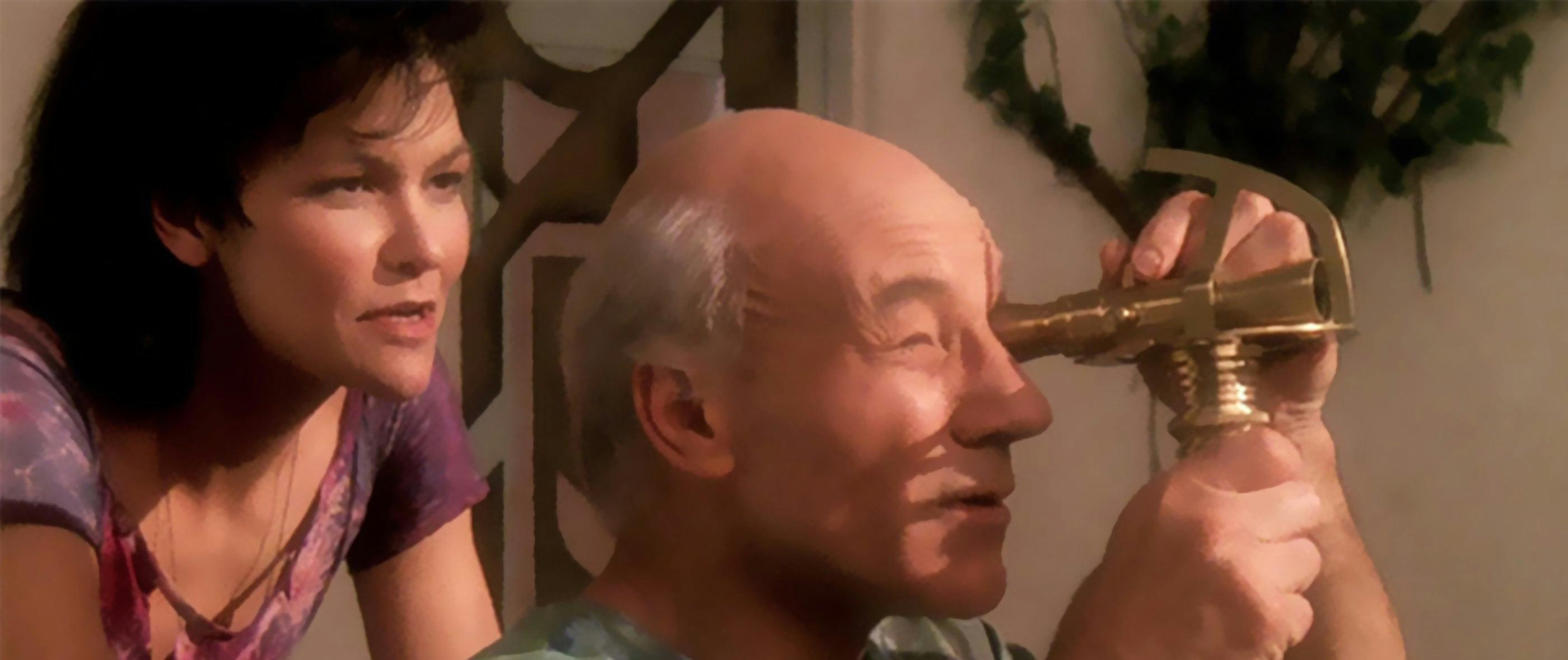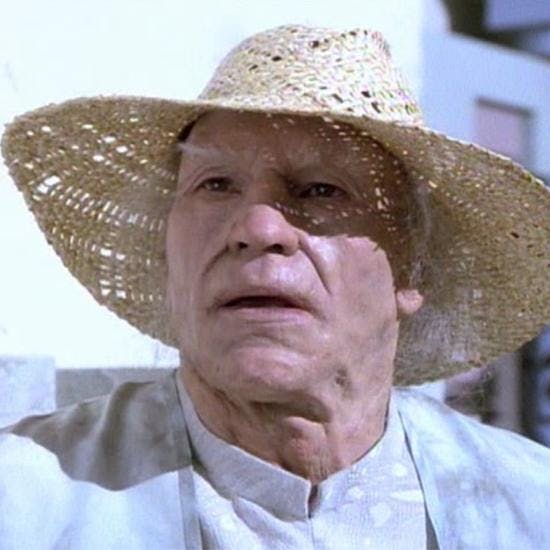Published Jul 2, 2016
Morgan Gendel on "The Inner Light's" 24th Anniversary
Morgan Gendel on "The Inner Light's" 24th Anniversary

I don’t know where you’ll be tonight but I know what I’ll be doing: taking “The Inner Light” out for its 24st birthday. We’ll toss back a few and reminisce and I’ll say things like, “Damn, time flies” and “The Inner Light” will probably say, “How do you think I feel; my episode felt like it took 50 years!”
Then we’ll both sober up and I’ll say, “Inner Light,” you’re the favorite of all my children because you come to the house regularly – usually via BBC America – and everyone I meet seems to love you so so so very much.” Then I’ll get all sloppy and “Inner Light” will look at his/her watch and make some excuse and just beam the hell out of there.
I can speak now, jokingly or otherwise, about my closeness to this singular episode of television, one of like 200 that I’ve written or produced. But it wasn’t always so. Star Trek: The Next Generation, unlike TOS, was a syndicated show, meaning that it was sold to individual station groups as opposed to one network. Two decades ago syndication signified a slight diminishment in cache.

The distinction seems laughable today, when my daughters watch most of their favorite shows on a phone. But suffice to say, my agent at the time was not pushing for me to write for TNG, not when a writer-producer job at NBC’s Law & Order awaited.
Who could have ever predicted, not just the love of all things genre but specifically, the adoration for this one episode of television? The result is, I’ve given more thought to the creation of “The Inner Light” than I have to any other single item you find on my IMDB listing. This won’t come as a surprise, but I don’t ever stay up til two ayem pondering why and how I came up with that “Unfinished Business” episode of Hunter I wrote back in the day.
So, why “The Inner Light”? Why does this episode stand out?
The answer – to the extent I know it – demonstrates the collaborative nature of TV production, particularly in its writing phase. My entry point into this story was not, as fans often assume, Picard’s tale of The Road Not Taken – giving the almighty starship captain a taste of hearth and home.
I had something different in mind. Prior to my TV writing career, before my brief stint as a network suit (it didn’t fit well; I felt more like a mock turtleneck), before even my years as a reporter at the Los Angeles Times, I was an advertising copywriter. The initial idea for “IL” fell into that wheelhouse. While looking out my toddler daughter’s window (she’s a college graduate now) I saw the Fuji blimp beckoning me to buy one brand of film over another. I began imagining its 24th century counterpart, beaming bespoke experiences into a potential buyer’s brain that would be indistinguishable from actual memories.
That’s right, it was all about a TV commercial from another galaxy that got blown off course – much as I guess my initial pitch had.
Picard was going to be stranded on some sort of resort planet and not understand that it was just an ad, not reality. At first, Riker and Ro Laren were zapped by the probe as well, and in their group mind-meld some sort of romantic triangle ensued. Well, at least romance was in the air! My cool tech notion morphed over many visits to the TNG writers room into the very moving tale of Picard Gets Family, Picard Loses Family, Picard Gets Back his Old Family.
That’s the collaborative part.
Paradoxically, “The Inner Light” also speaks to the peculiar benefits of being an outsider, some stubborn need to reside in your own box, not that other one over there that everyone else seems to like so much. In other words, the very opposite of collaboration.
It took me two decades to figure out that I was writing about myself. Time after time I passed through some unseen airlock into the cliquish TNG HQ on the Paramount lot to pitch my probe story, each subsequent rejection making me painfully aware of my outsider status. Not surprisingly – by which I mean I divined this after 24 years of hindsight – I wrote about a character not belonging yet trying to fit in, adapting to his new environment even while trying to turn the locals to his way of thinking. That character of course was Kamin, Picard’s alter ego, and the unfamiliar realm was this planet he learned to love, which fueled his quest against all odds to save it.

Nowhere was the extent of my own journey more evident than in the creation of The Flute. I don’t remember who in the room literally laughed at my suggestion but I recall it being greeted with the same enthusiasm as if I had said Picard would start visiting the bridge in a muumuu. I also don’t remember how impassioned my plea was, but I must have made a good closing argument because on my very next visit Michael Piller said he had reconsidered. The Flute lived!
The Tree of Life; the thinly veiled Bris, complete with obligatory cheese platter; the impending nova; the Green Lantern riff about searching the universe for one man good and true – all these story points went down a little more smoothly when I worked them into the prose story every TNG scribe had to write up before getting the green light to script. But those are all the trappings of the outlier, though I didn’t realize it at the time.
Once I figured that out, the universality of this story and hence its durability became clear. Isn’t every memorable drama, from The Graduate to The Dark Knight, from My So Called Life to Breaking Bad, about being different and trying to make the most of that difference? Trying to bring some order to our self-inflicted chaos? Trying to find some point to our lives?
Don’t we all long for our own “Oh, it’s me!” moment as the ancient Kamin did before the curtain was pulled back on the fictional lifelong pageant imbedded in his mind in 25 minutes?
I’m going to go out on a limb and say “Yes.”
But all those examples are of feature films or entire series. What sets “Inner Light” apart may be simply that I, not being part of the TNG episodic storytelling team, actually came up with something less like an episode and more like a little movie. In my later years, as a showrunner, I’m not sure I would’ve let a freelance writer get away with that, but for some reason they did.
And bee-tee-dubs, the “Oh it’s me!” line was written by my co-teleplay writer Peter Allan Fields. Finding the meaning to our outsider lives is good; having some insider collaboration even better.

On this 24th anniversary of “The Inner Light” I’m left with only one mystery. I often wonder if Jay Chattaway’s superb “Inner Light Theme” ever came to the attention of George Harrison, who wrote the little-known Beatles song for which I named the episode. The lyrics are so apt, it’s like some sort of artsy Mobius strip, song leading to story leading to song in one unbroken sequence. If you Google “Inner Light + song” you’ll get the Beatles tune and an acknowledgment of my TNG homage to it back-to-back. Don’t tell anyone but that might be the best gift my authorship of this episode has given me.
To anyone who can solve this mystery, I’ll buy you a drink.
In addition to “The Inner Light,” Morgan Gendel wrote the “Starship Mine” episode of TNG and the “Armageddon Game” and “The Passenger” episodes of Deep Space Nine. Since then, he has written for several primetime series, including Law & Order and served as Executive Producer of MTV’s Spider-Man animated series, Syfy’s The Dresden Files, and thePamela Anderson-starrer V.I.P., which was better than you think. He's currently the Co-Executive Producer of the CW sci-fi series, The 100 and has been interviewed extensively about “The Inner Light,” its deeper meaning and the time he spends at Trek and sci-fi conventions meeting with fans.

